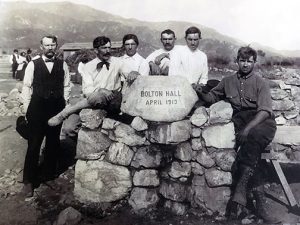In the Words of the Colonel
Six men stood around the large stone, which lay upon the ground. Chiseled into the rock face, all in capitals, were the words BOLTON HALL and, below that, APRIL 1913. Many hands were placed about the small boulder when designer and builder George Harris could be heard counting loudly, “One, two, three!” With that, his crew hefted this cornerstone into the air and placed it upon a wall that had been pre-prepared to hold it.
Just days ago, as I drove high into the hills on Angeles Crest Highway, I was daydreaming about such stories. I was on my way to speak before the Don Jose Verdugo Chapter of the National Society of Daughters of the American Revolution, and I would be sharing the recollections of Colonel Chancellor Esco Livingston.
Chan, as he was often called, had been present for the laying of Bolton Hall’s cornerstone at the age of 15 on Saturday, April 12, 1913 at the onset of the Little Lands Colony. Sixty-four years later, he stood on the steps of Bolton Hall to dedicate a plaque being affixed there by the Daughters of the American Revolution. He spoke before the gathering on May 7, 1977. Some of his words that day were as follows:
“Welcome, members of the DAR and the Little Landers Historical Society. I was a young man when this cornerstone was laid (as he pointed to the engraved rock nearby). My father, James Livingston, built the first house here and became a helper of the Little Landers founder, Mr. Hartranft. I remember the two often being growled at by eastern lot buyers who learned quickly that supporting a family was not easy on one acre of land.
“Since the average purchase price was $5 down and $10 per month, trying to keep things in balance with the monetary requirements was challenging. It was no surprise that Mr. Hartranft, the promoter, organizer and developer, grew a great deal of gray hair during those years.
“In 1913, approximately 250 folks were living here. I declare that every man, woman and child was present for the cornerstone celebration. One thing I recall was the constant dogfights between the mongrels that had followed their masters to the event. The streets were not paved so the dust from the ruckus annoyed the speakers.
“Many new settlers lived under harsh conditions. They lived in tents or quickly constructed shacks. They cooked meals outside or, for those fortunate to have a wood-burning stove, they were able to cook inside.
“There was unity amongst the colonists, but not exactly harmony. There was always that one person from Podunk or Brooklyn who enjoyed the sound of their own voice and believed that they alone had the approved solution for the community’s malfunctions. They could often upset the status quo.
“I later became associated with the U. S. Army and I’m thankful to have survived serving in combat zones in WWI, WWII and Korea. Upon retirement, I returned to Tujunga where I grew up as a boy, a place that I loved.”
These were some of the words of Colonel Livingston that day in 1977. A plaque was then ceremoniously affixed to stones near Bolton Hall’s front door. Alas, this marker disappeared decades ago, never to be seen again. I informed the ladies of the DAR of this fact and they soon did some digging.
Through their archives, they were able to find a document highlighting the event at Bolton Hall with information that had been lost. There was a description as to where the plaque was placed and, more importantly, the text of the plaque was noted.
“Bolton Hall, first public building in Tujunga. Dedicated August 1913. The Hannah Bushrod Chapter of the Daughters of the American Revolution. May 7, 1977.”

With this information, whispers of a new DAR plaque for the old hall have been heard on the wind.
